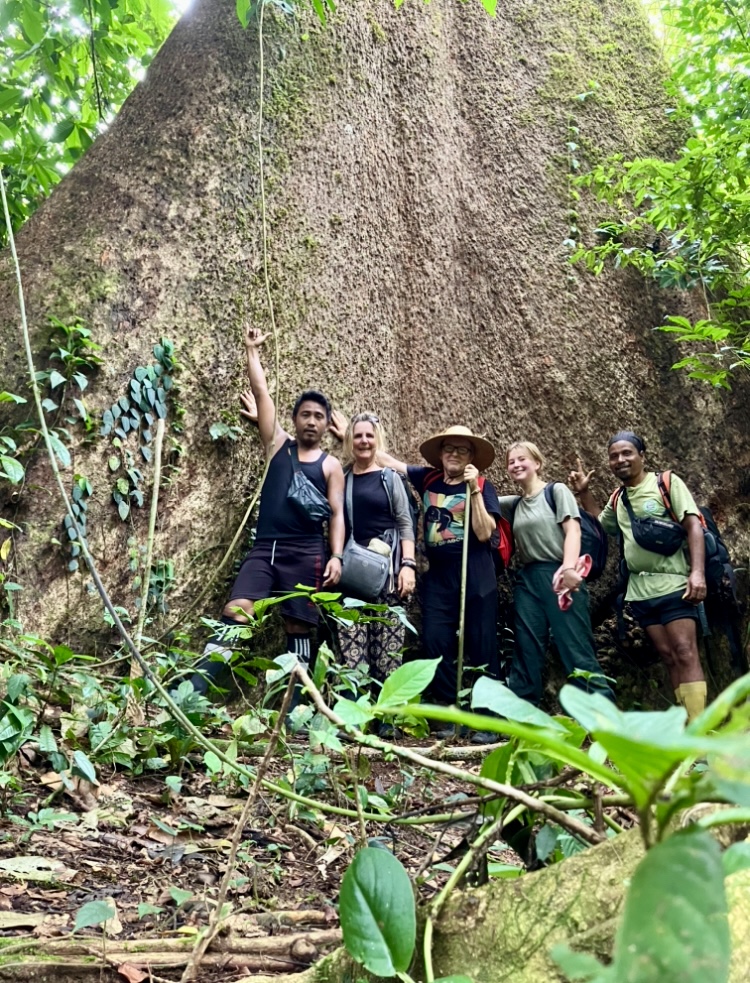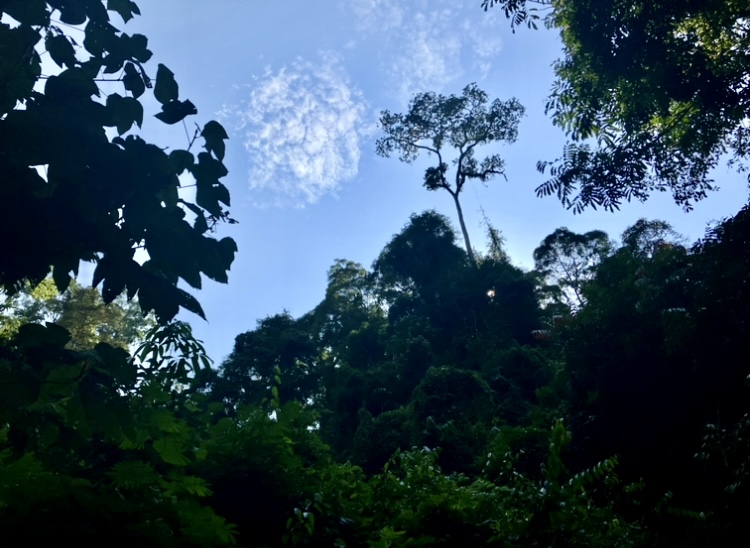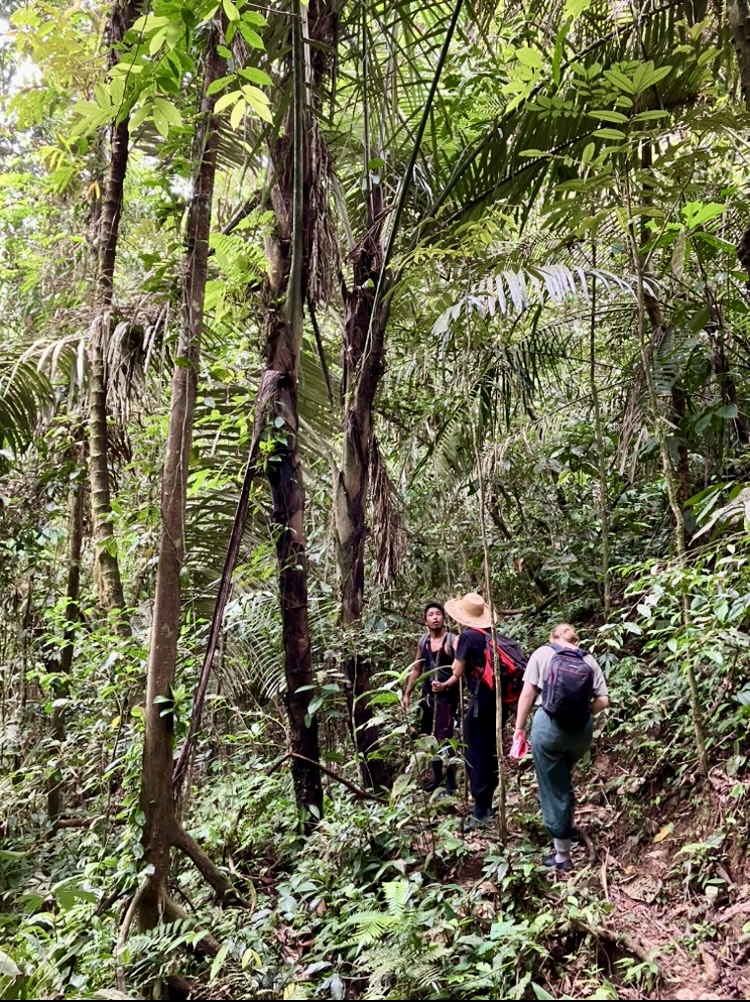Back to the Garden - Theo’s blog
Arriving in the village of Batu Katak to begin our “jungle trek” in the rainforest of Sumatra was like arriving to stay with a celebrity I’d been a fan of since childhood. I was full of anticipation for exotic sights and sounds, and dreaming of magical wildlife encounters, but at the same time, bracing myself for a less glamorous reality once I found out what the place was like when it wasn’t performing in the lens of a professional photographer.
And what I discovered was that wildlife, being wild, is rarely seen, that it’s called the rain forest because it rains a lot, ( although very thoughtfully on the part of Gaia, usually at night), and that rain = mud = leeches looking for ankles. I also discovered, regardless of leeches, the best and oldest living place on earth.
The walk from the village to our lodgings at “Orchid Bungalow” was a somewhat precarious path between the river rushing below us and the limestone cliffs above. The roaring waters were swollen with recent heavy rains and brown with mud from the banks they’d stripped of trees upstream. Tide marks higher than our heads spoke of inconceivable volumes of water cascading through the valleys, carving the wonderful crevasses and caverns in the cliffs over thousands of years, where beautiful collectives of diverse butterflies sunned themselves together and rose like clouds of confetti as we passed.
We learned from our hosts Joe and Herman, (native Karonese people who’d adopted western names for their tourist guests), that the river at Batu Katak was known as a pleasure spot for its clear water and gentle flow, but extremes of rain last year, which had swept away homes and at least 10 people further downstream, had left it muddy and cluttered with debris ever since. This had a knock-on effect on the national and international tourist economy that the village had been trying to rebuild post-pandemic. The rains continued, according to them, to be heavier than previous years, and we could sense the excited attention around our family trio in a place designed to receive more visitors than it currently attracts.
That evening we bathed in the clear and cleaner waters of a jungle stream that joined the river at Herman’s place, while Gibbons swung through the tree tops high overhead on their evening commute from the fruit trees on the mountain. This wasn’t jungle officially protected by the Gunung Leuser National Park we’d be visiting, but it was partially protected by decisions the villagers had taken themselves to limit cultivation and value the wild habitat, on an island where 56% of the Sumatran forest has been lost since 1985, replaced by row upon uniform row of corporate Palm Oil estates.
Villagers also had small plots of Oil Palms and other fruit where they backed onto the forested hills, and that was where, while I rested my injured knee in our lodging, Shannon and Rosa were lucky enough to see a mother and baby Orang Utan high among the leaves. It felt auspicious, but I hadn’t realised how rare such sightings could be.
I had a naive faith that we were bound to see more of the “man of the forest” once we started our trekking the next day. Standing aside for occasional off-road motorbikes heavily piled with wide loads of Oil Palm fruit, we walked on narrow paths to cross the river and find our trekking camp on the edge of the national park. On our way there, Joe showed us the plot where his own uncle was growing and tapping rubber trees, interspersed with Cacao and Mango. He was consciously trying to diversify from the higher-yielding quicker returns of the Oil Palms which had first appeared 20 years ago and now taken over from rubber as a cash crop. The disadvantage of Oil Palms is their thirst for water and nutrients which prevents other plants growing with them, whereas Rubber Trees can productively co-exist with other crops or even jungle. He mischievously showed us “rubbers greatest environmental contribution”, which his grandfather had shown him, dipping his finger into rubber sap oozing from the bark to produce a makeshift condom as it set!
The camp clearing of bamboo huts was in a buffer zone of uncultivated land which had been bought by an NGO between the untouched jungle of the national park and the small 3 or 4 acre plots owned by village farming families. This was the base from which we explored the rainforest, and to which we returned in the late afternoon to find out how many leeches had found a way under our clothes.
We scrambled and squelched through paths that, though well-worn, were freshly overgrown, our guides clearing the way with machetes. Much of the time we travelled by way of rocky streams that gave relief from the humid heat. We moved fairly quietly, but there was no way any of the Sun-bears, Pangolins, Golden Cats or Slow Loris that have been seen in the forest would be waiting around to meet us. Nonetheless, I can’t do justice to the dense richness of the landscape we were immersed in. In every space and at every level a different leaf, absurdly large and ancient tree trunks reaching high above, 9 inch millipedes and diverse busy little beetles, ants and shield bugs, hunted by branch-hopping chameleons, to the accompanying sounds of ringing bird calls, frogs, the booming of gibbons and rolls of distant thunder. You would not need to be sighted to appreciate the richness of the jungle. Since our journey through the world, I think that one of the best and easiest ways to connect to a place is to just close your eyes and listen to what the local birds have to say about it.
The sounds of the night were even more intense, almost too loud to sleep. Late one night I sat in the moonlit clearing of our camp transported by the orchestra of insect and amphibious sound, knowing that a Sumatran Tiger had visited here just two years ago, and dreaming they might do again. But they didn’t while I was there, and as we trekked along a stream on the last day, I had to accept that I was not likely now to see an Orang Utan either, even though it was the thought of them that had first made me want to come to this place.
Shannon and Rosa were sad that they had seen them but I hadn’t, and our guides were aware of that too. But I could just about be philosophical like them. I’d got to the point of letting go sufficiently that it was enough for me to be in a place where I knew that they existed, wild and free along with tigers and even Sumatran Rhinos. I switched my concern to our locals Happy and Joe, still scanning the forested hillsides and making their imitation Orang Utan calls. I thought, it would be nice for them to find some.
We were resting near the point where we’d be leaving the national park to climb onto inflatable rings and hurtle back down the big river to the village, when Happy suddenly alerted us. He’d glimpsed an Orang Utan group in the branches crossing the gap downstream from us. We’d been resting with our shoes off and now without a thought we were racing as quietly as possible after Joe along the overgrown path, all fear of leeches forgotten. And then, there they were, rustling and swinging amoung the leaves of a high tree on the opposite bank, barely visible until a young one swung effortlessly across the gap like a long-limbed hairy man.
If we had gone to the more accessible rehabilitation centre for orangutans at Bukit Lawang, we could have got much closer to primates who are used to being around humans, and if we’d had time, I’d have liked that. But as it was, we had been blessed with a wild sighting of creatures for whom our world was unimportant, before they melted away again into theirs. This was the wilderness which once banded the whole earth and from which all primates, including us, emerged.
The previous evening, me and Shan had contemplated a delightful group of Thomas Leaf monkeys munching through the foliage, and I’d seen the many-layered forest as one great rain-generating organism sustaining many lives. It’s awesome that it exists here in its same original majesty, and terrifying that it may yet be finally erased for little more than a short-lived blip of human consumption. Really, we need the worlds people to support all communities in these frontline situations with the resources they need to have an alternative income, but that’s not going to happen soon. For my part, I come away with a commitment to helping halt the March of the Oil Palms however I can.
A precarious “eco-tourism” industry dependant mainly on wealthy westerners flying around the world, is better by far than nothing, but hardly going to be enough to guarantee the jungles survival, especially with the stresses of climate change, fed paradoxically by the aviation emissions of travellers. But if hunters and growers like the villagers of Batu Katak can start to see themselves as proud protectors, that’s potentially making a difference – at least slowing the destruction until the global eco-cidal machine ceases to function, as one day it must. At that point, these islands of wild Gaia might once more become the nurseries for nature to repopulate the earth with her infinite creativity.
- Theo, March 2024






Thanks Theo, loved your words as ever ❤️